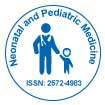Impact of Gestational Diabetes in Pregnant Women and the Neonate
Received: 18-Aug-2021 / Accepted Date: 01-Sep-2021 / Published Date: 08-Sep-2021 DOI: 10.4172/2572-4983.s8.1000002
Introduction
Gestational diabetes (a condition in which your blood sugar levels become high during pregnancy) regularly shows up in pregnancy. Some women experience gestational diabetes in more than one pregnancy. Experts routinely test for it in the span of 24 and 28 weeks of pregnancy.
Gestational diabetes can be controlled by regulating food habits and by doing ordinary exercises. Now and then women with gestational diabetes should likewise take insulin.
Problems of Gestational Diabetes in Pregnancy
C-Section (Cesarean Section)
Cesarean Section is also known as C-section. It is one of the surgeries in which the baby is taken out of the mother’s womb by making an incision on the belly of the mother. In most cases, mothers can have a normal vaginal birth but due to some complications like if the mother is carrying a large baby (macrosomia), C-section is required. Even the mothers with GDM (Gestational Diabetes Mellitus) can have a normal vaginal birth but they're more likely to have a c-section than women without GDM.
High blood pressure (Preeclampsia)
Preeclampsia: It is a pregnancy complication where there will be high blood pressure and will show signs of damage to another organ system, most often the liver and kidneys. It usually begins after 20 weeks of pregnancy in women whose blood pressure had been normal. It’s a term most commonly used for Hypertension which indeed means High Blood pressure it normally happens when the force of the blood against the blood vessel walls is too high. Preeclampsia is when a pregnant woman has high blood pressure. The signs of Preeclampsia are proteinuria (protein in urine), vision changes, severe headaches. This may lead to premature birth.
Premature birth
If birth happens before 37 weeks of pregnancy it is known as premature birth. Normally women with GDM can have a full-term pregnancy that is 39 to 40 weeks in case of any complications during the pregnancy; the labor is induced before the due date which includes the medications which break the amniotic sac.
Causes
Gestational diabetes happens when our body cannot produce the additional insulin required during pregnancy. Insulin, a chemical made in the pancreas, helps the body use glucose for energy and helps control blood glucose levels.
During pregnancy, the body makes uncommon chemicals and goes through different changes, for example, weight acquire. Despite these changes, the body's cells don't utilize insulin appropriately, a condition called insulin resistance. All pregnant ladies have some insulin obstruction during late pregnancy. Most pregnant ladies can deliver sufficient insulin to beat insulin resistance, however, some can't. These women foster gestational diabetes.
Being overweight is connected to gestational diabetes. Pregnant women who are overweight may have insulin resistance when they become pregnant.
Having a family background of diabetes makes it almost certain that a lady will foster gestational diabetes.
Prevention
Tragically, gestational diabetes indications, similar to Type 2 diabetes. This asymptomatic beginning is the reason for numerous obstetricians decides to test the entirety of their patients.
Since there are no gestational diabetes indications, the most ideal approach to keep away from them is proactive anticipation:
Eat high fiber, low-fat food varieties with an accentuation on vegetables and entire grains. Stay away from "white food sources" like sugar, flour, pasta, and potatoes, which increase glucose levels.
30 minutes of daily activity can diminish the dangers of getting gestational diabetes. Strolling, swimming, and yoga can help to decrease the pregnancy complications.
Get thinner preceding pregnancy. Obstetricians don't suggest weight reduction during pregnancy, yet in case of anticipating becoming pregnant, thinning down in advance can assist with having a better pregnancy.
If danger factors are high, examine them with the obstetrician. Testing early and regularly can help to get gestational diabetes before it conceivably influences pregnant women and the child.
Citation: Alex D (2021) Impact of Gestational Diabetes in Pregnant Women and the Neonate. Neonat Pediatr Med S8: 002. DOI: 10.4172/2572-4983.s8.1000002
Copyright: © 2021 Alex D. This is an open-access article distributed under the terms of the Creative Commons Attribution License, which permits unrestricted use, distribution, and reproduction in any medium, provided the original author and source are credited.
